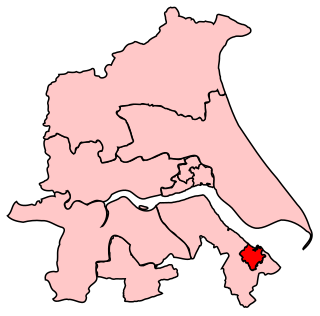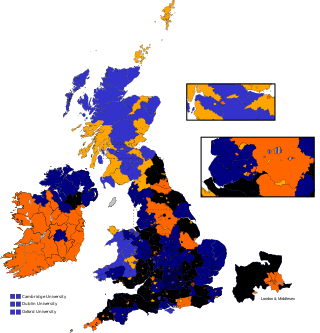
Great Grimsby is a constituency in North East Lincolnshire represented in the House of Commons of the Parliament of the United Kingdom since December 2019 by Lia Nici of the Conservative Party. Between 1918 and 1983 it was known simply as Grimsby; following the 2023 Periodic Review of Westminster constituencies, the seat will be subject to boundary changes which will incorporate the neighbouring town of Cleethorpes. As a consequence, it will be renamed Great Grimsby and Cleethorpes, to be first contested at the next general election.

South Northamptonshire is a constituency represented in the House of Commons of the UK Parliament since its 2010 recreation by Andrea Leadsom, a Conservative who served as Secretary of State for Business, Energy and Industrial Strategy until 13 February 2020. She was Leader of the House of Commons from 2017 to 2019, and Secretary of State for Environment, Food and Rural Affairs from 2016 to 2017. The seat of South Northamptonshire is considered a Conservative safe seat with having elected a Conservative MP at every election for 110 Years. Current Conservative MP Andrea Leadsom was re-elected in 2019 with an increased majority.

North Derbyshire was a Parliamentary constituency in the United Kingdom. It returned two Knights of the Shire to the House of Commons of the Parliament of the United Kingdom.
Hertford was the name of a parliamentary constituency in Hertfordshire, which elected Members of Parliament (MPs) from 1298 until 1974.

North Riding of Yorkshire was the constituency of the North Riding of Yorkshire. It returned two Members of Parliament to the House of Commons of the Parliament of the United Kingdom.
North Northamptonshire was a county constituency in Northamptonshire, represented in the House of Commons of the Parliament of the United Kingdom.

South Devon, formerly known as the Southern Division of Devon, was a parliamentary constituency in the county of Devon in England. From 1832 to 1885 it returned two Knights of the Shire to the House of Commons of the Parliament of the United Kingdom, elected by the bloc vote system.

East Kent was a county constituency in Kent in South East England. It returned two Members of Parliament (MPs) to the House of Commons of the Parliament of the United Kingdom, elected by the first past the post system.

South Northumberland was a county constituency of the House of Commons of the Parliament of the United Kingdom. It was represented by two Members of Parliament (MPs), elected by the bloc vote system.
Stamford was a constituency in the county of Lincolnshire of the House of Commons for the Parliament of England to 1706 then of the Parliament of Great Britain from 1707 to 1800 and of the Parliament of the United Kingdom from 1801 to 1918. It was represented by two Members of Parliament until 1868 when this was reduced to one.
South Wiltshire, formally known as the Southern division of Wiltshire or Wiltshire Southern was a county constituency in the county of Wiltshire in South West England. It returned two Members of Parliament to the House of Commons of the Parliament of the United Kingdom, elected by the bloc vote system.

East Suffolk was a county constituency in Suffolk, England. It elected two Members of Parliament to the House of Commons of the Parliament of the United Kingdom by the bloc vote system of election.

West Norfolk or Norfolk Western was a county constituency in the county of Norfolk, which returned two Members of Parliament (MPs) to the House of Commons of the Parliament of the United Kingdom, elected by the bloc vote system.
North Staffordshire was a county constituency in the county of Staffordshire. It returned two Members of Parliament (MPs) to the House of Commons of the Parliament of the United Kingdom, elected by the bloc vote system.

North Nottinghamshire, formally the "Northern Division of Nottinghamshire" was a county constituency represented in the House of Commons of the Parliament of the United Kingdom. It elected two Members of Parliament (MPs) by the block vote system of election.
South Nottinghamshire, formally the "Southern Division of Nottinghamshire" was a county constituency represented in the House of Commons of the Parliament of the United Kingdom. It elected two Members of Parliament (MPs) by the bloc vote system of election.
North Leicestershire, formally the "Northern Division of Leicestershire", was a county constituency represented in the House of Commons of the Parliament of the United Kingdom. It elected two Members of Parliament (MPs) by the bloc vote system of election.
Mid Lincolnshire, formally called the Mid Division of Lincolnshire, was a county constituency in Lincolnshire. It returned two Members of Parliament (MP) to the House of Commons of the Parliament of the United Kingdom, elected by the bloc vote electoral system.

South Lincolnshire, formally called the Southern Division of Lincolnshire or Parts of Kesteven and Holland, was a county constituency in Lincolnshire. It returned two Members of Parliament (MPs) to the House of Commons of the Parliament of the United Kingdom, elected by the bloc vote electoral system.

Thomas George Corbett (1796–1868) was an English Member of Parliament, and High Sheriff of Lincolnshire in 1840.





